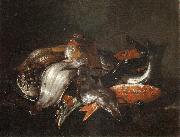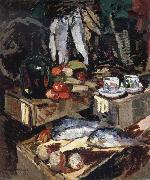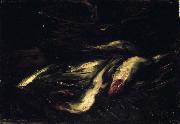
|
RECCO, Giuseppe
|
|||
|
|
|||
| Italian Baroque Era Painter, 1634-1695 Son of Giacomo Recco. He was the most celebrated Neapolitan still-life painter of his day. He began in the tradition of his father and (probable) uncle Giovan Battista Recco, painting naturalistic arrangements of flowers, fish, game and kitchen scenes. There are many signed and dated works which chart the development of his style. The Bodeg?n with a Negro and Musical Instruments (1659; Madrid, Medibacoeli priv. col.), the Bodeg?n with Fish (1664; Paris, Moret priv. col.) and the Kitchen Interior (1675; Vienna, Ksthist. Mus.) are close to the art of Giovan Battista Recco. The fish and kitchen still-lifes are typically Neapolitan, yet Giuseppe's art is distinguished by the intensity with which he observes light and surface texture and by the clarity of the composition, based on a careful balance of horizontals and verticals. He moved toward a more Baroque and decorative style, and the unfinished Still-life with Fruit, Flowers and Birds (1672) and the Still-life with Fruit and Flowers | |||
|
|
|||
|
Fish new3/RECCO, Giuseppe-876936.jpg Painting ID:: 30010 |
mk67 Oil oncanvas 20 1/16x25in | ||
|
|
|||
|
Konstantin Korovin
|
|||
|
|
|||
| 1861-1932 Russian Konstantin Korovin Galleries Konstantin was born in Moscow to a merchant family officially registered as peasants of Vladimir gubernia. His father, Aleksey Mikhailovich Korovin, earned a University degree and was more interested in arts and music than in the family business established by Konstantin's grandfather. Konstantin's older brother Sergey Korovin was a notable realist painter. Konstantin's relative Illarion Pryanishnikov was also a prominent painter of the time and a teacher at the Moscow School of Painting, Sculpture and Architecture. In 1875 Konstantin entered the Moscow School of Painting, Sculpturing and Architecture, where he learned from Vasily Perov and Alexei Savrasov. His brother, Sergey was already a student of the School. During their scholar years Korovins became friends with their fellow students Valentin Serov and Isaac Levitan, Kontantin kept these friendship through the whole of his life. In 1881-1882, Korovin spent a year at the Imperial Academy of Arts in Saint Petersburg, but returned disappointed to the Moscow School of painting, sculpturing and architecture. He studied at the school under the new teacher Vasily Polenov until 1886. In 1885, Korovin made traveled to Paris and Spain. Paris was a shock for me?? Impressionists?? in them I found everything for what I was scolded back at home, in Moscow, he later wrote. Korovin. On the balcony, Spanish women Leonora and Ampara. 1897-1898.Polenov introduced Korovin to Savva Mamontov's Abramtsevo circle: Viktor Vasnetsov, Apollinary Vasnetsov, Ilya Repin, Mark Antokolsky and others. The Abramtsevo circle's love for stilized Russian themes is reflected in Korovin's picture A Northern Idyll. In 1885 Korovin works for Mamontov's Opera house. He designed the stage decor for Giuseppe Verdi's Aida, L??o Delibes' Lakme and Georges Bizet's Carmen. St. Triphon's Brook in Pechenga. 1894.In 1888, Korovin traveled with Mamontov to Italy and Spain, where he produced painting On the balcony, Spanish women Leonora and Ampara. Konstantin traveled within Russia, Caucasus and Central Asia, exhibited with Peredvizhniki. He was painting in the Impressionist and later in the Art Nouveau style. In the 1890s, Korovin became a member of the Mir iskusstva art group. Korovin's subsequent works was strongly influenced by his travel to the North. In 1888 he was captivated by the stern northern landscapes, as seen in The Coast of Norway and The Northern Sea. His second trip to the North, with Valentin Serov in 1894, coincided with the construction of the Northern Railway. Korovin painted a large number of landscapes: Norwegian Port, Saint Trifon's Brook in Pechenega, Hammerfest: Aurora Borealis, The Coast at Murmansk and others. The paintings are built on a delicate web of shades of grey. The etude style of these works was typical for the Korovin's art of the 1890s. Using material from his northern trip, Korovin designed the Northern Railway pavilion at the All Russia Exhibition of 1896 at Nizhny Novgorod. In 1900, Korovin designed the Central Asia section of the Russian Empire pavilion on the Paris World Fair; and was awarded the Legion of Honour by the French government. Spring, 1917In the beginning of the 20th century Korovin focused his attention on the theatre. He moved from Mamontov's opera to Mariinsky Theatre in Saint Petersburg. Departing from the tradition of the stage decor, which only indicated the place of action, Korovin produced a mood decor, which conveyed the general emotions of the performance. Korovin designed sets for Constantin Stanislavski's dramatic productions, as well as Mariinsky's operas and ballets. He did the stage design for such Mariinsky's productions as Faust (1899), The Little Humpbacked Horse (1901) and Sadko (1906) that became famous for their expressiveness. Pier in Gurzuf, 1914In 1905, Korovin became an Academician of Painting, and in 1909-1913 he was a professor at the Moscow School of Painting, Sculpture and Architecture. One of the artist's favourite themes was Paris. He painted A Paris Cafe (1890s'), Cafe de la Paix (1905'), La Place de la Bastille (1906), Paris at Night; Le Boulevard Italien (1908'), Night Carnival (1901), Paris in the Evening (1907) and others. During the World War I Korovin worked as a camouflage consultant at the headquarters of one of the Russian armies and was often seen at the front line. After the October Revolution Korovin continued to work in the theatre, designing stage for Richard Wagner's Die Walk??re and Siegfried as well as Pyotr Ilyich Tchaikovsky's The Nutcracker (1918-1920). In 1923 Korovin moved to Paris by the advice of the Commissar of Enlightenment, Anatoliy Vasilievich Lunacharsky, to cure his heart condition and help Korovin's handicapped son. There was supposed to be a large exhibition of Korovin's works but the works were stolen and Korovin was left penniless. For years he produced the numerous Russian winters and Paris boulevards just to make ends meet. In the last years of his life he produced stage designs for many of the major theatres of Europe, America, Asia and Australia, the most famous of which is his scenery for a production by the Turin Opera House of Nikolai Rimsky-Korsakov's The Golden Cockerel. Korovin died in Paris on September 11, 1939. Konstantin's son Alexey Korovin (1897-1950) was a notable Russian-French painter. Because of an accident during his childhood he had both feet amputated. Alexey committed suicide in 1950. | |||
|
|
|||
|
Fish new11/Konstantin Korovin-634796.jpg Painting ID:: 37263 |
mk121 1916 Oil on canvas 106x88cm | ||
|
|
|||
|
Henri Matisse
|
|||
|
|
|||
| French Fauvist Painter and Sculptor, 1869-1954 Henri Matisse is considered the most important French artist of the 20th century and, along with Pablo Picasso, one of the most influential modernist painters of the last century. Matisse began studying drawing and painting in the 1890s. A student of the masters of Post-Impressionism, Matisse later made a reputation for himself as the leader of a group of painters known as Les Fauves. An ironic label given to them by a critic, the name reflected Matisse's aggressive strokes and bold use of primary colors. In 1905 Matisse gained sudden fame with three paintings, including Woman with the Hat, purchased by the wealthy American ex-patriot Gertrude Stein. Beyond painting, he worked with lithographs and sculpture, and during World War II he did a series of book designs. Later in his career he experimented with paper cutouts and designed decorations for the Dominican chapel in Vence, France. Along with Picasso, | |||
|
|
|||
| This artist (Henri Matisse) is not available now. | |||
|
|
|||
|
Antoine Vollon
|
|||
|
|
|||
| (April 23, 1833 - August 27, 1900) was a French realist artist, best known as a painter of still lifes, landscapes and figures. During his lifetime, Vollon was a successful celebrity, enjoyed an excellent reputation, and was called a "painter's painter". | |||
|
|
|||
|
Fish new24/Antoine Vollon-469564.jpg Painting ID:: 72600 |
Date between 1871(1871) and 1875(1875) Medium Oil on canvas Dimensions 32.7 X 46.7 cm (12.87 X 18.39 in) cyf | ||
|
|
|||
|
Also Buy::. For Following Paintings / Artists / Products, Please Use Our Search Online: |










